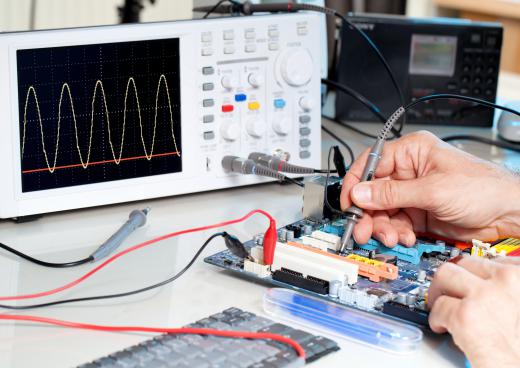What is a Spectrum Analyzer?
Within given parameters, a spectrum analyzer measures electrical, audio, or optical waveform frequencies. It is extremely sensitive, and is particularly useful in mechanical and electrical technical measurements. The spectrum, or spectral, analyzer separates and measures incoming or transmitted signals and orders them according to their frequencies. Analysis of the spectral results can help determine the physical and electrical performance of the item being measured.
When used with radio frequency circuitry, a spectrum analyzer can measure the noise, frequency of response, signal-to-noise ratio, and distortion inherent in a radio frequency. A common industrial use of this type of analyzer is found in the telecommunications field. They are used in this field to track interference and determine bandwidth.

Spectrum analyzers can be used in almost any modern signaling process. Optical analyzers can be used to measure the output of light-emitting devices, such as lasers or diodes. An optical spectrum analyzer can be set to measure the light beams that are emitted.
Much can be learned about electrical signals through the use of an oscilloscope; however, an oscilloscope only shows how the signal varies with time. A spectrum analyzer can measure that, and give a graphical representation of the amplitude of the signal frequency. A multitude of measurements can be determined by a spectral analyzer that an oscilloscope cannot measure. These include such things as signal stability and power output, various distortions, and bandwidth.
It is very important that the correct analyzer be chosen for a given job. There are two basic types of spectrum analyzers: analog and digital. Each has its advantages and disadvantages, and the choice must be determined by the parameters of the job.
An analog analyzer can work with higher frequencies than a digital analyzer. Some users think the digital analyzer is superior, however, because it can produce better frequency resolution. The answer may lie in what has become known as a hybrid analyzer. This analyzer uses a superheterodyne receiver, as does an analog spectrum analyzer, to convert high-frequency input into a low frequency that a digital analyzer can work with. The digital element then produces its results using a mathematical formula called the Fast Fourier Transformation (FFT).
While most people are totally unaware of it, a spectrum analyzer may very well be a part of one's everyday life. Loudspeakers and tape recorders alike often use spectrum analyzers to measure performance and frequency response. They can be important in determining microwave and satellite alignment. Spectrum analyzers are also quite often found in various industries to measure sound levels.
AS FEATURED ON:
AS FEATURED ON:











Discussion Comments
@Mammmood - I think that mastering and remastering is a science unto itself. I’ve never done any of it myself, but I know that you can get some freeware spectrum analyzer software that will show you the waveforms of an audio sample, if you want to get into that sort of thing.
If you’ve ever owned a digitally remastered CD collection of a vintage rock band, you can thank audio spectrum analyzer technology.
It’s my understanding that these CDs are first converted into digital format from their original analog form, and then put through a spectrum analysis process to improve the final output.
The term “improve” is somewhat open to interpretation I suppose, but usually it means a better signal to noise ratio, like the article talks about, and also enhancing the sounds of the individual instruments to bring out better clarity and volume.
I think in the majority of the cases the audio does sound much better than the original.
Post your comments